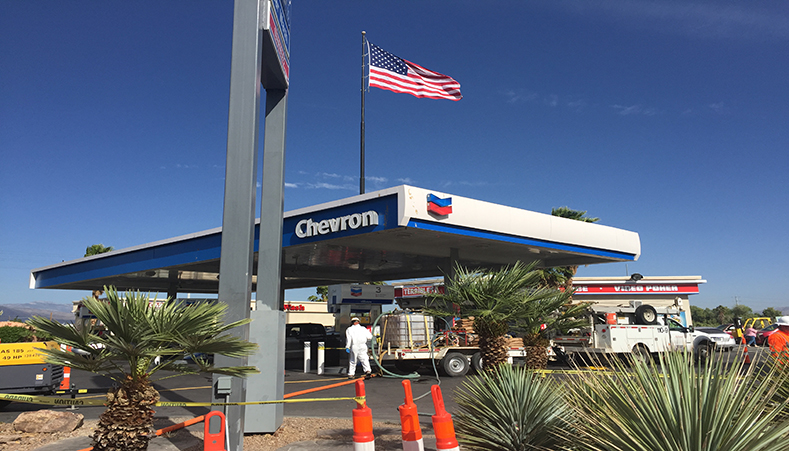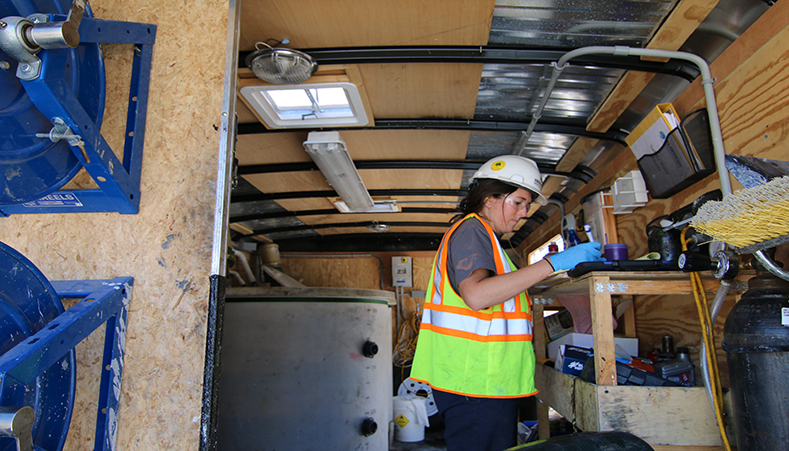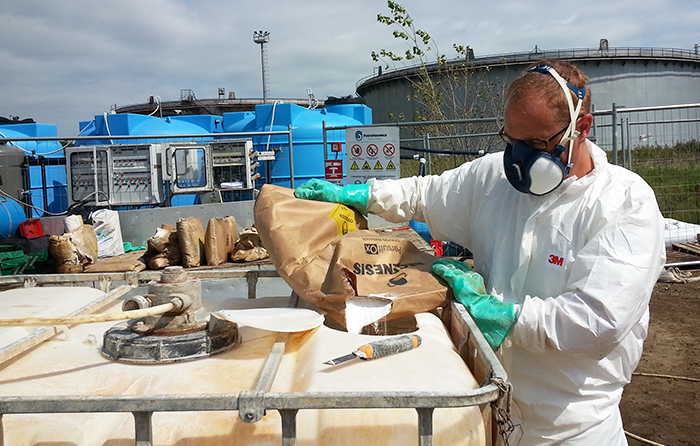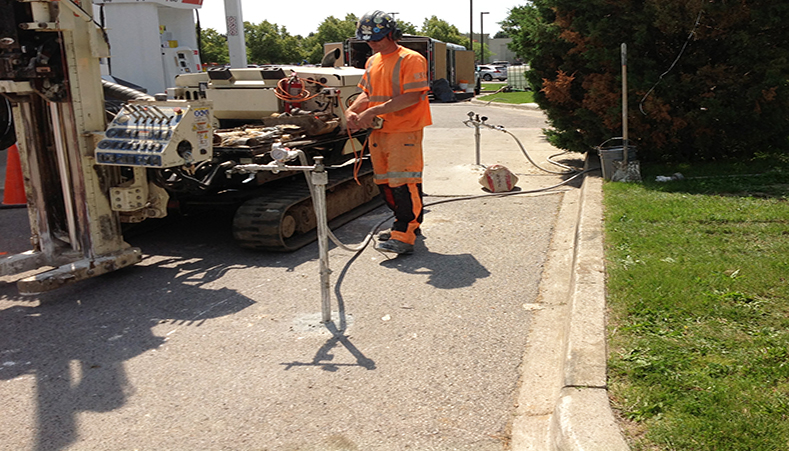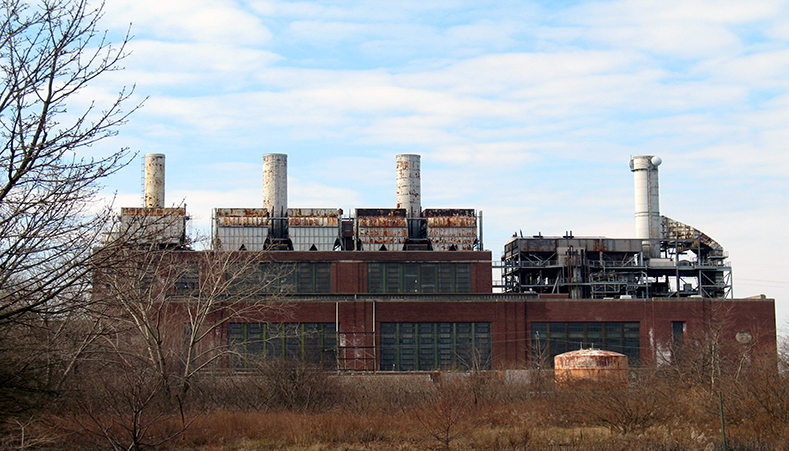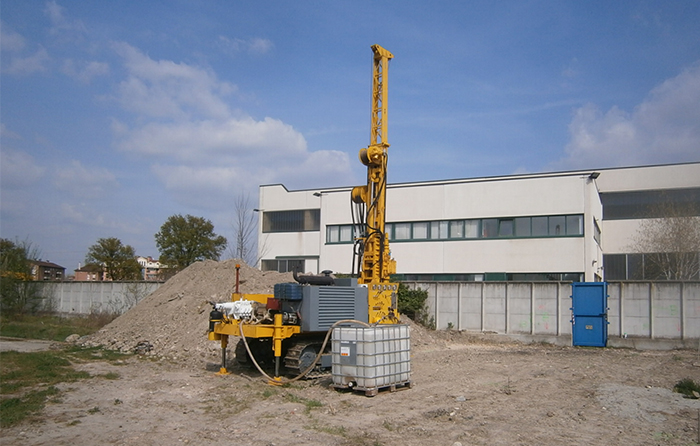ORC Advanced® and PersulfOx® Application Reduces BTEX, TPHg, and TPHd at an Active Service Station in Las Vegas
Significant cost savings to client achieved using enhanced aerobic biodegration and In Situ Chemical Oxidation (ISCO)Read More
Contaminant Concentrations at an Active Gas Station Reduced by 90% Using PersulfOx® and ORC Advanced®
REGENESIS Uses an Outside-In Application to Push 30-Year Old LUST Case to Closure in Remote Region of Arizona
Project Highlights
- Innovative “Outside-In” approach incorporated injection design working from perimeter of the treatment area first, and progressively working toward the center
- First event application completed within seven days with a second event completed in nine days the following month without disruption to active site
- Closely managed injection wells to ensure proper distribution and avoid surfacing

Project Summary
An active gasoline station in Springerville, AZ was listed as a hazardous Leaking Underground Storage Tank (LUST) site by the state of Arizona. After 30 years of unsuccessful remediation using a number of approaches, REGENESIS Remediation Services (RRS) was contacted to perform two separate injection events approximately one month apart. Both events included injections at 15 injection points over a range of depths. The first round of injections included a combination of PersulfOx and ORC Advanced. The second round of injections contained only PersulfOx.
During both injections PersulfOx and ORC Advanced were successfully applied within the treatment area and at the targeted treatment interval of 18 to 60 ft. bgs. Low to moderate injection pressures and application flow rates were observed at each of the injection well locations, indicating good distribution of the amendments. Increases in dissolved oxygen, conductivity, pH, and oxidation-reduction potential were observed, indicating good distribution and influence of the PersulfOx and ORC Advanced remediation chemistry.
Technology Description
PersulfOx is an advanced in situ chemical oxidation (ISCO) reagent that destroys organic contaminants found in groundwater and soil through abiotic chemical oxidation reactions. It is an all-in-one product with a built-in catalyst which activates the sodium persulfate component and generates contaminant-destroying free radicals without the costly and potentially hazardous addition of a separate activator. The patented catalyst enhances the oxidative destruction of both petroleum hydrocarbons and chlorinated contaminants in the subsurface.
ORC Advanced is an engineered, oxygen release compound designed specifically for enhanced, in situ aerobic bioremediation of petroleum hydrocarbons in groundwater and saturated soils.
Results
Since the two injections have been completed, three rounds of groundwater monitoring have been performed. Benzene concentrations have been reduced by 90% to 20 μg/L. A closure request has been submitted by the client awaiting regulatory approval.
State-Funded Cleanup of Former Service Station on Reservation Land
Enhanced Aerobic Biodegradation and In Situ Chemical Oxidation Provides Safe Approach to Remediate TPH-g and BTEX
Project Highlights
- Extensive coordination was required between state-funded Pollution Liability Insurance Agency (PILA) of Washington and US EPA Region 10
- Combined remedy approach using ORC Advanced® and PersulfOx® provided a safe solution for land used to raise livestock

Project Summary
The site located in Wapato, Washington is a former gas station situated on Reservation Land with historical releases dating back >20 years. The site is regulated through US EPA Region 10 and was previously an empty lot used for ranging cattle.
Initial remedial activities included excavation of source-area soil, however persistent contamination remained. Concerns were raised regarding how amendments might affect livestock. As a result, the remediation approach needed to be environmentally benign. The revised remedial plan included Enhanced Aerobic Biodegradation (ORC Advanced) and In Situ Chemical Oxidation (PersulfOx) to reduce the remaining concentrations and meet regulatory goals.
Technology Description
PersulfOx is a chemical oxidant that rapidly reduces the mass of the contaminants. This chemical consists of 90% sodium persulfate and 10% catalyst powder. PersulfOx is very effective in rapid oxidation of petroleum hydrocarbons in both soil and groundwater.
ORC Advanced is an engineered, oxygen release compound designed specifically for enhanced, in situ aerobic bioremediation of petroleum hydrocarbons in groundwater and saturated soils.
Results
An integrated treatment strategy was devised, which included injections in three separate areas. Two areas were treated with PersulfOx and ORC Advanced. The third area was treated with ORC Advanced only.
The by-products of ORC Advanced and PersulfOx are both insoluble and non-toxic, making the application safe and effective. Consequently, there were no issues relating to the landowner’s concern for amendments affecting livestock. A total area of 4,100 ft2 was treated for high levels of BTEX and TPH-g. Monitoring is ongoing.
ISCO and Bioremediation at Former Petrol Station, Pays de la Loire, France
Under a former petrol filling station in the Loire Valley, in France the soil and groundwater was found to be contaminated with petroleum hydrocarbons (primarily BTEX). An integrated in-situ remedial solution has been put in place by a specialist remediation contractor, consisting of 26 PersulfOx injections in the source zone for fast and effective treatment of the most impacted soils and groundwater. ORC Advanced was also applied in the source zone to achieve long term in-situ bioremediation of any remaining petroleum hydrocarbons. In addition, an ORC Advanced barrier has been installed in the downstream plume area, to prevent off-site migration of the contamination.Read More
REGENESIS Remediation Services’ Efficient ISCO Treatment Keeps Redevelopment Schedule of Former Gas Station On Track
Project Highlights
- Three distinct zones of contamination effectively treated by in situ chemical oxidation (ISCO) and enhanced aerobic bioremediation
- Benzene (BTEX) concentrations in groundwater reduced by >99% within three months, achieving site goals for Low-Threat Closure (LTC)
- The treatment, design and application efficiency provided by REGENESIS® Remediation Services allowed the redevelopment schedule to be maintained
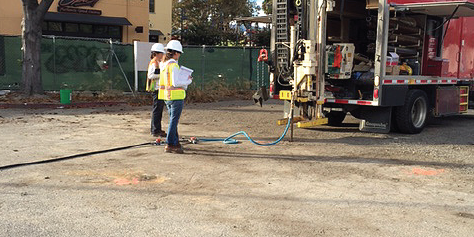
Project Summary
Operations at the site of a former gas station in San Jose, California resulted in contamination of the subsoil and groundwater with benzene. Following demolition of the station after 15 years of operation, the site was approved for redevelopment into a commercial property. However, the site failed to meet the groundwater criteria of the Low-Threat Underground Storage Tank Case Closure Policy (LTCP) for benzene (<3,000 μg/L) concentrations, and remediation activities were quickly undertaken in order to maintain the schedule for site redevelopment.
A remediation plan was developed by REGENESIS® that utilized in situ chemical oxidation and enhanced aerobic biodegradation to address the residual petroleum contamination at the site. Due to the extended drought in the area that caused rapidly declining groundwater levels, three separate zones of contamination were targeted in the remediation plan: the groundwater zone and two newly-formed vadose zones that are separated by a low-permeability unit. The 3700 ft2 treatment area included full coverage by the groundwater treatment as well as two distinct regions of the shallow and deep vadose zones.
A bench test using soil and groundwater from the site was performed to verify the effectiveness of the planned course of treatment prior to full-scale application. A >99% reduction in benzene concentrations confirmed the remediation plan, and application of the remediation chemistry was performed by REGENESIS Remediation Services (RRS) over two injection events. Due to the prolonged drought in the area, recycled water was brought on site for use in the field activities. The two injection events were separated by one month and each spanned ten days. During the first event, PersulfOx® was applied via direct push technology to 54 injection points. In the second event, ORC Advanced® was co-applied with PersulfOx through 59 points.
Technology Description
PersulfOX is a sodium persulfate-based chemical oxidation technology that destroys both hydrocarbon and chlorinated solvent contaminants in the subsurface. PersulfOx contains a built-in catalyst that activates the persulfate component and generates contaminant-destroying free radicals without the need for the addition of a separate activator.
ORC Advanced is a proprietary formulation of food-grade, calcium oxyhydroxide that produces a controlled release of molecular oxygen to enhance aerobic biodegradation.
Results
Three months after treatment of the site was completed, BTEX concentrations decreased by over 99% from the baseline concentrations of 3070 μg/L. Furthermore, concentrations of all contaminants have been reduced to below the criteria for Low Threat Closure, and as a result of this rapid achievement of site goals, the redevelopment schedule of the site has been preserved.
Chlorinated Solvent Remediation via ISCO at Former Industrial Site in Barcelona, Spain
Due to the target area extending under the footprint of the proposed building and the short build programme, a grid of horizontal injection pipes was installed in the subsurface prior to construction commencing. The grid was then linked to a remote injection location, so that when the new building was constructed, injection was simultaneously completed underneath it. The intention of the remediation was to achieve a rapid and significant reduction of the contaminant concentrations in the groundwater. PersulfOx was selected as the preferred ISCO agent due to its efficiency and capability of moving through the vadose zone into the groundwater, guaranteeing a good distribution.Read More
Pilot Test of ISCO Soils Treatment in Industrial Area, Italy
At a former oil refinery in Italy, leaks from several large Aboveground Storage Tanks (ASTs) had caused the soil to become impacted with fuel. Concentrations of up to 3,000 mg/kg of petroleum hydrocarbons were measured in the unsaturated soil within the immediate vicinity of the ASTs. Read More
Innovative Application of PersulfOx Addresses BTEX Contamination at Former Gas Station Site
Project Highlights
- Innovative remediation plan designed by IRSL to address hydrocarbon plume using PersulfOx® addresses migrating plume
- Cleanup criteria on site was reached with only two injections of PersulfOx
- Direct Push Technology using PersulfOx counters any back diffusion

Project Summary
An active gasoline station in southwestern Ontario exhibited a hydrocarbon plume, which was migrating off site toward commercial buildings, presenting liability concerns for developers. Previous remediation efforts using other oxidants, including base-activated persulphate, did not result in significant reductions, and rebound was a problem, including pH buffering. InSitu Remediation Services, Ltd. (IRSL) was the consulting firm hired to perform the remediation work.
Led by Rick McGregor, IRSL designed an approach that included REGENESIS’® PerfulfOx to address the concentrations in the plume including BTEX ~ 25 mg/L, F1 ~29 mg/L, and F2 ~ 1.5 mg/L. The geology was silty sand with sand lens and a unconfined aquifer. The client’s cleanup goals were F1 0.75 mg/L and F2 0.15 mg/L. Two injections of PersulfOx using Direct Push Technology (DPT) were applied, targeting the sand lens and providing enough mass to allow for diffusion of PersulfOx into the silty sand to counter back diffusion.
Technology Description
PersulfOX and PersulfOX SP promote the rapid and sustained in situ oxidation of a wide-range of organic contaminants. As an advanced in situ chemical oxidation (ISCO) reagent, it destroys organic contaminants found in groundwater and soil through abiotic chemical oxidation reactions.
This turn-key, all-in-one product with a built-in catalyst activates the sodium persulfate component and generates contaminant-destroying free radicals without the costly and potentially hazardous addition of a separate activator. The patented catalyst enhances the oxidative destruction of both petroleum hydrocarbons and chlorinated contaminants in the subsurface.
With the purchase and proper use of PersulfOx Catalyzed Persulfate, clients gain the benefits of the latest advancements in persulfate technology for environmental remediation. PersulfOx SP was formulated for use on projects specifying the use of persulfate and a separate chemical activation process such as alkaline activation, hydrogen peroxide activation, or iron activation. It can also be used as a follow-on treatment to REGENESIS’ PersulfOx Catalyzed Persulfate technology.
Results
Following the two injections of PersulfOx using direct push technology, cleanup criteria was reached quickly, resulting in two-plus years of sublevel monitoring.
About InSitu Remediation Services
One of Canada’s most experienced remediation companies, InSitu Remediation Services Ltd. (IRSL) has designed, implemented, and maintained soil and groundwater remediation programs in diverse geological environments in North, Central, and South America, Europe and the Middle East. The company offers remediation support services and specializes in ensuring the most efficient use of technical and financial resources, managing shortened remedial time-frames, and mitigating unnecessary technical and financial risk.
Rick McGregor, B.Sc. Geology, M.Sc. Hydrogeology, M.B.A., is president of InSitu Remediation Services Ltd. A respected environmental professional with over a quarter century in environmental assessment and remediation, he has designed and implemented remediation programs across the globe.

New Jersey Manufacturing Facility Achieves Non-Detect with PersulfOx® Application where Pump and Treat Solution Failed
Project Highlights
- Replacing a costly pump and treat solution, REGENESIS® was able to efficiently inject PersulfOx® into bedrock, saving time and money
- Maximum 580 μg/L levels of 1,1-DCE and 1,4-dioxane within the source area reduced to non-detect
- Low-level concentrations of 1,1-DCE surrounding the original treatment area also reduced to non-detect
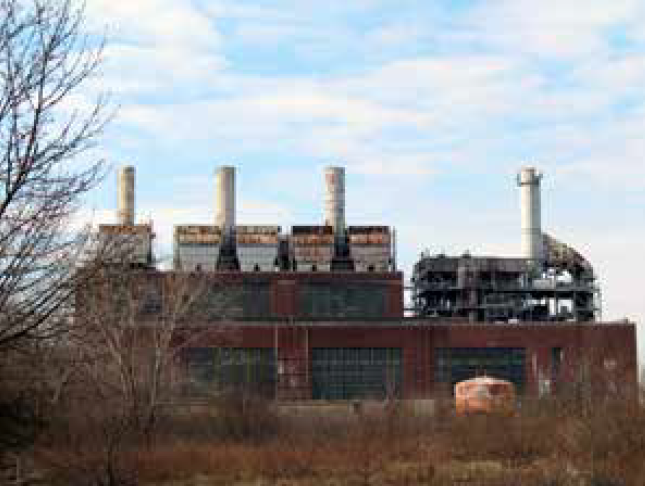
Project Summary
A former manufacturing facility in New Jersey was contaminated with 1,1-dichloroethylene (1,1-DCE) and 1,4-dioxane in a fractured bedrock aquifer. The previous treatment approach utilized a pump and treat method that was successful at containing and reducing contaminant concentrations within the source area, but the associated off-site transportation and disposal of recovery water was expensive.
Historic concentrations for 1,1-DCE within the source area ranged from 43-580 μg/L, and concentrations outside of the immediate source area persisted at low levels above Ground Water Quality Standards. 1,4- dioxane concentrations within the source area peaked at 580 μg/L.
PersulfOx in situ chemical oxidation (ISCO) was selected as a lower-cost alternative to the pump and treat method and also as a way to address the diffuse contamination surrounding the immediate treatment area. After application of PersulfOx, both 1,1-DCE and 1,4-dioxane concentrations within the source area rapidly decreased below detection levels and remained non-detect. In addition, the low levels of 1,1-DCE surrounding the original treatment area were also reduced to non-detect. Quarterly groundwater sampling will continue to track treatment performance.
Technology Description
PersulfOx is a sodium persulfate-based chemical oxidation technology that destroys both hydrocarbon and chlorinated solvent contaminants in the subsurface. PersulfOx contains a built-in catalyst that activates the persulfate component and generates contaminant-destroying free radicals without the need for the addition of a separate activator.
Results
Application of PersulfOx resulted in the rapid reduction of source area 1,1-DCE and 1,4-dioxane concentrations to below detection limits. Low concentrations of 1,1-DCE surrounding the original treatment area were also reduced to non-detect. The concentrations of contaminants in both areas have remained below groundwater quality standards, meeting site requirements.
Treating Aniline Compounds at a Former Pharmaceutical Plant
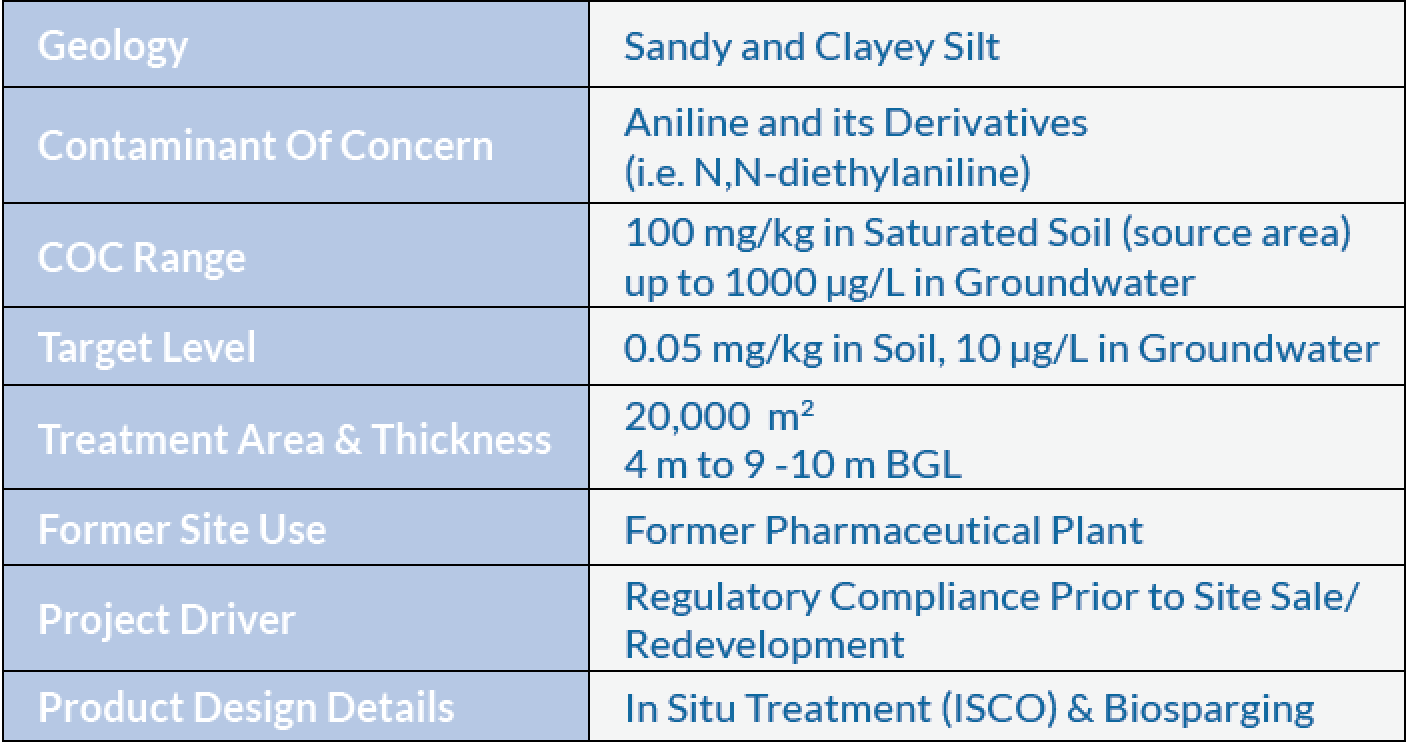
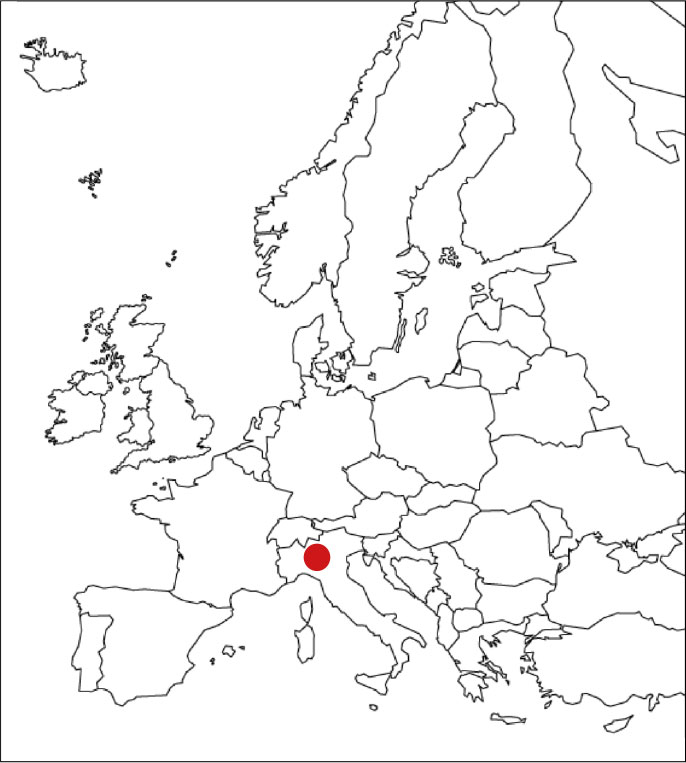
Introduction
The soil and groundwater under a disused pharmaceutical plant in the North of Italy had become impacted with a mixture of aniline and its derivatives, due to historic spillages and leaks on the site. The contaminated unsaturated soil had been removed previously by excavation and disposal (approx. 1,000-1,500 m2) to a depth of 5 m BGL. However, some contamination had infiltrated through the vadose zone and impacted the groundwater, resulting in a 100-meter long plume. In the source area, residual contamination adsorbed to the saturated soil had been detected at 6-9 m BGL; below the maximum depth of the excavation previously completed. It was observed that during periods of high precipitation, the groundwater level would rise and promote recurrent desorption events from this contaminant mass into the groundwater.
Copernico S.r.l was engaged to delineate the contamination through additional site investigation using Membrane Interface Probe (MIP). They found that the main contaminant of concern (COC) was N,N-diethylaniline, which was present at concentrations of approx. 100 mg/kg in saturated soil in the source area, and up to 1,000 μg/L in groundwater across the whole of the site.
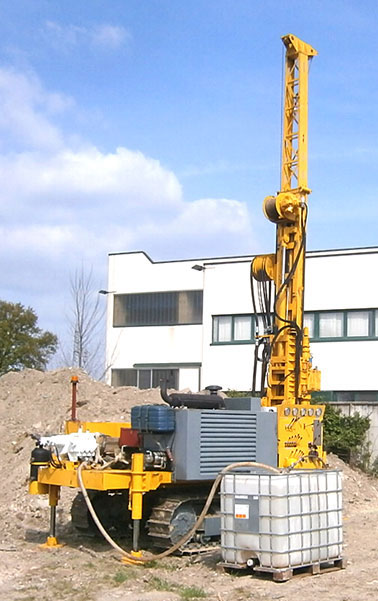
Fig. 1 Installation of injection points
Remediation Strategy
A laboratory study previously performed on material and contaminants from this site had shown that aniline was biodegradable under aerobic conditions (especially N,N-diethylaniline). Following this, a biosparge pilot scale study was completed, which proved unsuccessful at dealing with the high concentrations and contaminant loading in the source area. Copernico therefore determined that an integrated remediation approach would be required; initially using ISCO to rapidly address the higher concentrations and then enhanced biological degradation to treat the residual dissolved phase contamination.
It was determined that a persulphate-based ISCO agent was to be applied in two injection campaigns to treat the high levels of adsorbed contamination. After this, the biosparging system would then be operated both in the source and in the plume area. At the downstream boundary of the site, an ongoing pump & treat (P&T) system was used to provide hydraulic containment of the plume within the property, in line with regulatory requirements.
For the ISCO phase, Copernico selected PersulfOx®, a sodium persulfate oxidant with a patented catalyst already mixed into the product. Therefore, no hazardous activation products are required, making the treatment process much safer. The application volume is therefore also reduced, providing cost and time savings to the project.
PersulfOx promotes rapid and sustained ISCO of a wide range of organic oxidants including aniline, through both alkaline activation and surface mediated oxidation on the catalytic surface. This makes the treatment more efficient and effective compared to traditionally based persulfate based ISCO.
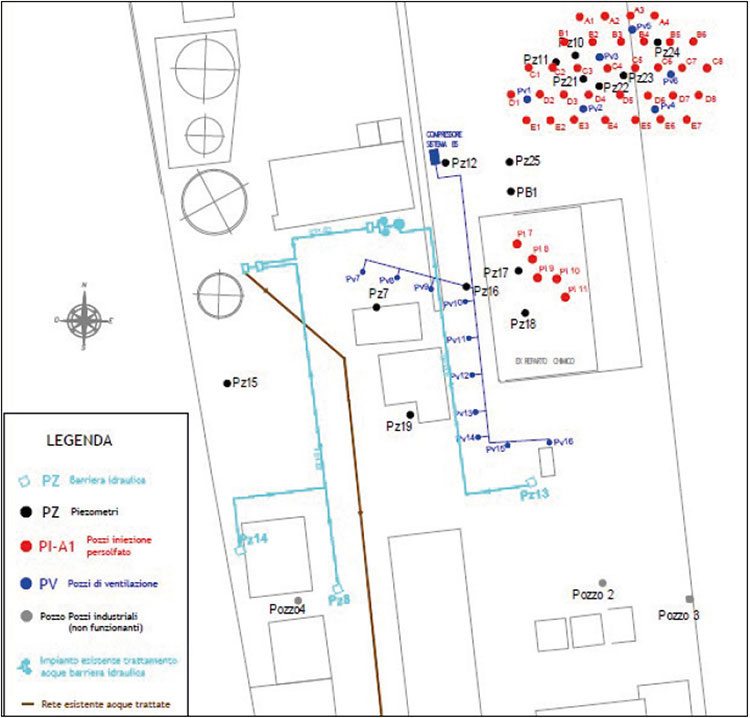
Fig.2 Map showing the PersulfOx injection points (red), Biosparging wells (blue), P&T system (light blue), monitoring wells (dark)
PersulfOx Injection Works
Within the target area 33 injection points (A1-E7), were installed within the vicinity of monitoring wells Pz11, Pz17, Pz18, Pz22, Pz23 and Pz24 (Fig.2).
7,000 kg of PersulfOx was mixed with water to a 15-20% dilution prior to injection into the source area. PersulfOx is simply added to water and agitated, with no requirement for hazardous activation chemicals (such as caustic soda or hydrogen peroxide), making the process much safer, quicker and requiring a lower injection volume (see fig. 3 and 4).
PersulfOx was applied into the injection wells between 6 and 9 m BGL.
A special well completion was used that allowed the application to be completed in 500 mm vertical intervals, in order to ensure an even vertical distribution of the PersulfOx application (fig. 5 and 6). A dose of 25 kg PersulfOx to 175 L of water was applied within each section at approximately 5 Bar or less. A manifold system was used that allowed application into several wells at once in order to make the injection more efficient. The works were completed in 20 days.
Following the initial ISCO application to reduce the contaminant loading in the soils and groundwater in the source area, the biosparge system was operated to provide enhanced natural attenuation of the residual dissolved phase contamination. The biosparge system consisted of 5 ventilation points in the secondary source area, and a second line of 10 points in the plume area; all ventilation points are 15 meters deep.
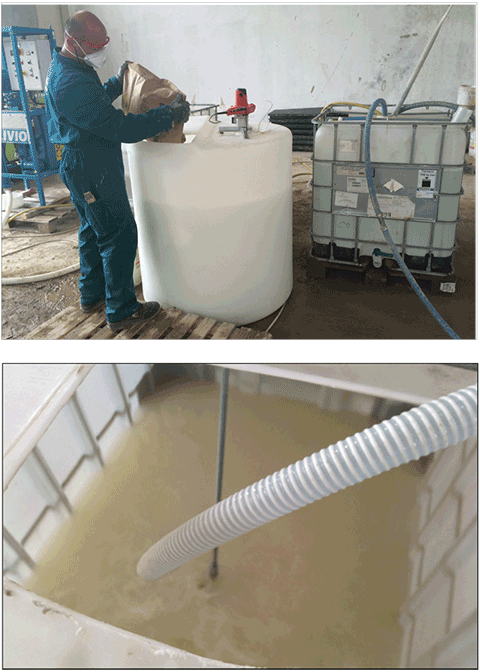
Fig.3 and 4 Mixing activities
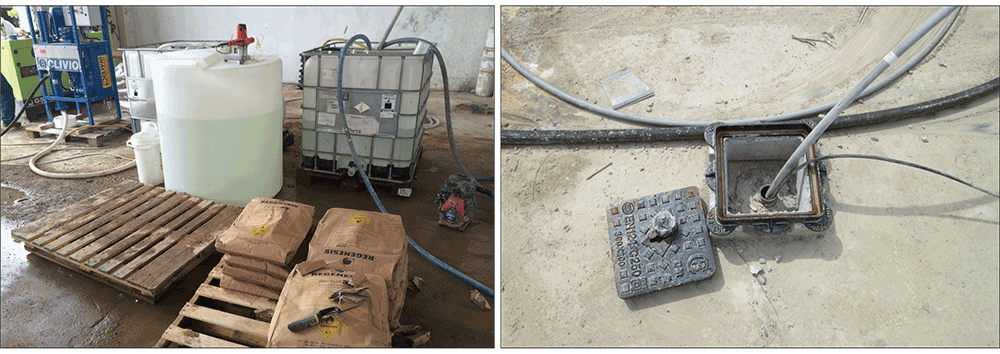
Fig. 5 and 6 Injection setup and multi-valve injection points
Results
The first PersulfOx injection campaign was carried out during the months of May and June 2014. Monitoring results from October 2014 show significant, rapid and sustained reduction in all of the Contaminants of Concern (COCs) and remedial targets have been achieved for;
- Aniline (12 out of 12 wells in treatment area)
- N,N-diethylaniline (10 out of 12 wells in the treatment area)
- N-ethylaniline (11 out of 12 wells in treatment area)
The efficacy of the remediation has been monitored through a network of 20 monitoring wells across the site (20,000 m2). Periodical monitoring campaigns have been carried out, including chemical-physical field parameters and laboratory analysis.
Immediately following injection, a temporary increase in the groundwater concentrations of the aniline(s) was observed. This was due to desorption of part of the soil contamination due to the disturbance of the injection and the effect of the ISCO treatment. Once the contamination was in the groundwater, it was rapidly oxidised and the concentrations were then seen to reduce rapidly.
An example of this is well Pz11 (located in one of the most highly impacted areas (7,000 μg/L)), see Figure 7, producing a significant contaminant mass reduction of the whole system (sorbed and aqueaous phase), with a 99% reduction in dissolved phase concentrations by October 2014.
ISCO using PersulfOx not only provided contaminant mass reduction from both the soils and groundwater. Partial chemical oxidation of the COCs resulted in the contaminants becoming more bioavailable and biodegradable. This increased the efficacy of the biosparging system on the residual dissolved phase contamination.
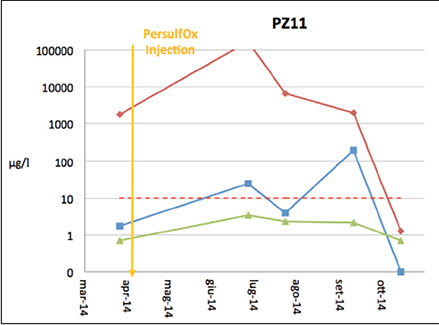
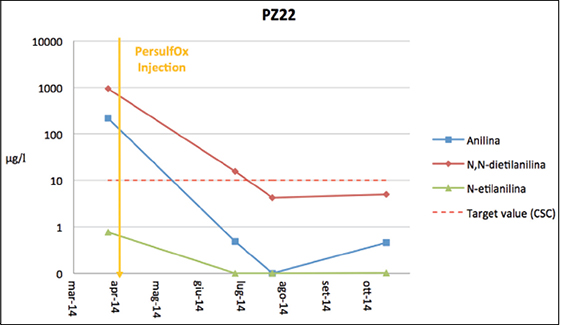
Fig. 7 Total COC concentrations decreased below the target values in Pz11 and Pz22 (Shallow portion of the aquifer) with the use of PersulfOx in 6 months after application.
In the PersulfOx treatment area, all monitoring wells met the target goals within six months for all COCs except for two deep wells (Pz10 and PB1) that still show concentrations marginally higher than target. It is thought that these wells represent areas with higher contaminant mass than was anticipated. Subject to further groundwater monitoring results, a second PersulfOx application may be completed at the site, targeting the recalcitrant wells, as foreseen in the remediation plan. This treatment will be smaller than the first, accurately targeting source areas with higher total contaminant mass.
Biosparging will then be continued in these areas to enhance the biological degradation of the residual dissolved phase contamination. Downgradient of the biosparging system a significant decrease in groundwater aniline concentration has been observed reducing from 1,000 μg/L to <0.1 μg/L. After the remediation activities, aniline concentrations have not exceeded targets (10 μg/L) at the boundary pumping wells, despite periods of heavy rainfall. The remediation resulted in a significant reduction of contaminant mass across the treatment area for all COCs and the residual concentrations are expected to decline further over time.
Conclusions
An intelligent, staged approach was used to complete the site investigation and development of an integrated remediation strategy for the site. This comprised accurate contaminant delineation using Membrane Interface Probe (M.I.P.), evaluation of potential remedial strategy and verification of localised geological and geochemical conditions across the site. This resulted in an accurate in situ remedial design, integrating rapid mass reduction of the COCs
and enhanced biological degradation of the residual dissolved phase contamination.
The treatment successfully reduced COC concentrations to below target goals in the majority of the treatment area and continued to reduce the contaminant levels throughout the validation period.
This site is an excellent example of how good site investigation and an integrated treatment design strategy can provide cost effective and assured remediation of problematic contaminants.
About the Product
PersulfOx is an advanced in situ chemical oxidation (ISCO) reagent rapidly destroys a wide range of contaminants such as petroleum hydrocarbons and chlorinated solvents through abiotic chemical oxidation reactions.
It is an all-in-one product with a built-in catalyst which activates the sodium persulfate component and generates contaminant-destroying free radicals without the costly and potentially hazardous addition of a separate activator. The patented catalyst enhances the oxidative destruction of both petroleum hydrocarbons and chlorinated contaminants in the subsurface.
Benefits
- Promotes rapid and sustained in situ oxidation of a wide range of organic contaminants
- Contains a built-in catalyst that remains active through the entire lifespan of the persulfate oxidation reaction
- The catalyst also eliminates the need for the co-application of alternate and potentially hazardous activation chemistries
- Contaminant oxidation performance equivalent to best alternative persulfate activation methods
- Fewer health and safety concerns than with use of traditional activation methods such as heat, chelated metals, hydrogen peroxide or base
- Single component product results in simplified logistics and application
- No additional containers or multi-step mixing ratios required prior to application
- Compatible with combined remedy approaches including enhanced
biodegradation
PersulfOx Intellectual Property
With the purchase and proper use of PersulfOx Catalyzed Persulfate, Regenesis’ customers gain the benefits of the latest advancements in persulfate technology for environmental remediation.
Furthermore, through an arrangement between Regenesis and FMC Corporation, PersulfOx customers are free to use PersulfOx without any risk of patent infringement claims from FMC Corporation.

 Americas
Americas Europe
Europe Français
Français Deutsch
Deutsch Italiano
Italiano Español
Español